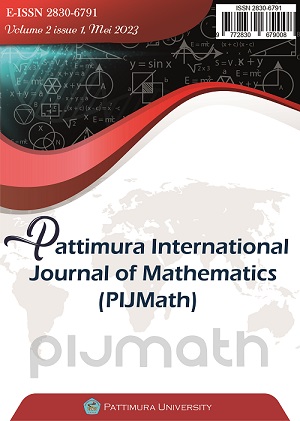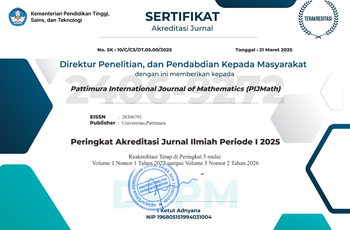Application of Classification Data Mining Technique for Pattern Analysis of Student Graduation Data with Emerging Pattern Method
Abstract
Data mining has been applied in various fields of life because it is very helpful in extracting information from large data sets. Student graduation data is one example of data that can be extracted for information and become a recommendation. This study used a classification data mining technique to extract information from the student graduation data. The classification technique used was the Emerging Pattern method to search for patterns in the student graduation data. The data in this study were graduation data for students of the Statistics Study Program, Faculty of Mathematics and Natural Sciences, Tanjungpura University, from 2013-2018. The sample data used amounted to 186 records. Attributes used in this study include as many as four attributes, including gender, batch, GPA, and TUTEP scores. This research began by finding the class and frequency values obtained. It was continued by calculating each item set's support, growth rate, and confidence values. This study obtained the highest confidence value among all the attributes owned, namely 91% in the 2013 batch itemized list and the 2018 batch. Female students dominated the class attribute. TUTEP dominated the TUTEP value attribute with a score of 425, and the GPA attribute of 3.51-4.00 dominated the class with a confidence value of 60%.
Downloads
References
G. Dong and J. Li, “Efficient Mining of Emerging Patterns: Discovering Trends and Differences,” p. 10.
Asriningtias, Y., and Mardhiyah, R., Aplikasi Data Mining untuk menampilkan Informasi Tingkat Kelulusan Mahasiswa [Data Mining Application to Display Student Graduation Rate Information], Journal of Informatics, 8 (1), 2014.
C. C. Aggarwal, Data Mining. Cham: Springer International Publishing, 2015. doi: 10.1007/978-3-319-14142-8.
M. Irfan, “Analisa Pola Asosiasi Jalur Masuk Terhadap Kelulusan Mahasiswa Dengan Menggunakan Metode Fold-Growth (Studi Kasus Fakultas Sains Dan Teknologi),” [Analysis of Association Patterns of Entry Paths to Student Graduation By Using The Fold Growth Method (Case Study of The Faculty of Science and Technology)] no. 2, p. 19, 2015.
J. Han and M. Kamber, Data mining: concepts and techniques, 2nd ed. in The Morgan Kaufmann series in data management systems. Amsterdam ; Boston : San Francisco, CA: Elsevier ; Morgan Kaufmann, 2006.
P.-N. Tan, M. Steinbach, and V. Kumar, “Introduction to Data Mining,” p. 169.
P. S. Bradley, U. M. Fayyad, and O. L. Mangasarian, “Mathematical Programming for Data Mining: Formulations and Challenges,” Inf. J. Comput., vol. 11, no. 3, pp. 217–238, Aug. 1999, doi: 10.1287/ijoc.11.3.217.
Suaidah, Warnars, H., L., H., S., and Damayanti, Implementasi Supervised Emerging Patterns pada Sebuah Atribut: (Studi Kasus Anggaran Pendapatan dan Belanja Daerah (APBD) Perubahan pada Pemerintah DKI Jakarta) [Implementation of Supervised Emerging Patterns on an Attribute: (Case Study of Regional Expenditure Budget (APBD) Changes in the DKI Jakarta Government)]. TINF-015, 2018.
M. S. Mustafa, M. R. Ramadhan, and A. P. Thenata, “Implementasi Data Mining untuk Evaluasi Kinerja Akademik Mahasiswa Menggunakan Algoritma Naive Bayes Classifier,” [Implementation of Data Mining to Evaluate Student Academic Performance Using the Naïve Bayes Classifier Algorithm]. Creat. Inf. Technol. J., vol. 4, no. 2, p. 151, Jan. 2018, doi: 10.24076/citec.2017v4i2.106.
D. A. Yosepta and T. Aprilianto, “Analisa Pola Kelulusan Mahasiswa Pada Sekolah Tinggi Manajemen Informatika & Komputer Asia Malang Dengan Menggunakan Algoritma Iterative Dichotomiser 3 (ID3),” [Analysis of Student Graduation Patterns at the Asian School of Informatics and Computer Management Malang By Using the Iterative Dichotomiser 3 (ID3)] vol. 3, p. 9, 2017.
G. Dong, X. Zhang, L. Wong, and J. Li, “CAEP: Classification by Aggregating Emerging Patterns,” p. 15.
N. Nuruliyani and H. L. H. S. Warnars, “Prototype Data Mining Pola Jabatan Fungsional Dosen Menggunakan Teknik Emerging Pattern: Studi Kasus Universitas Mercu Buana,” [Prototype Data Mining Pattern of Lecturer Functional Position Using Emerging Pattern Technique: Case Study of Mercu Buana University] PIKSEL Penelit. Ilmu Komput. Sist. Embed. Log., vol. 7, no. 2, pp. 211–224, Sep. 2019, doi: 10.33558/piksel.v7i2.1842.
I. Farida and S. W. H. L. Hendric, “Prediksi Pola Kelulusan Mahasiswa Menggunakan Teknik Data Mining Classification Emerging Pattern,” [Prediction of Student Graduation Patterns Using Data Mining Classification Emerging Pattern Techniques] PETIR, vol. 12, no. 1, Apr. 2019, doi: 10.33322/petir.v12i1.414.
Y. T. Utami, “Penerapan Supervised Emerging Patterns Untuk Multi Atribut Pada Data Online Izin Usaha Pertambangan di Indonesia (Studi Kasus: Eiti Indonesia),” [Application of Supervised Emerging Patterns for Multiattribute on Online Data of Mining Business Licence in Indonesia (Case Study: Eiti Indonesia)] p. 7, 2016.
S. Angriani, S. Neva, and P. Hendra, “Penerapan Data Mining Untuk Memprediksi Status Kelulusan Pada Jalur SNMPTN Menggunakan Algoritma Naïve Bayes Classifier,” 2022.
Copyright (c) 2023 Aditya Handayani, Neva Satyahadewi, Hendra Perdana

This work is licensed under a Creative Commons Attribution-NonCommercial 4.0 International License.
The author(s) hold the copyright of the published article without restriction. This policy means that the journal allows the author(s) to hold and retain publishing rights without restrictions.
The author(s) holds the copyright of published articles without limitation. This policy means that the journal allows the author to hold and retain publishing rights without restrictions. Journal editors are given the copyright to publish articles in according to agreement signed by the author and also include statement of originality of the article


.jpg)












 This work is licensed under a
This work is licensed under a 